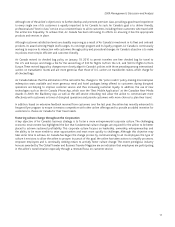Air Canada 2009 Annual Report Download - page 21
Download and view the complete annual report
Please find page 21 of the 2009 Air Canada annual report below. You can navigate through the pages in the report by either clicking on the pages listed below, or by using the keyword search tool below to find specific information within the annual report.2009 Management’s Discussion and Analysis
21
Ownership costs decreased 2% from the fourth quarter of 2008
Ownership costs, comprised of depreciation and amortization, and aircraft rent expense, of $250 million in the fourth
quarter of 2009 decreased $4 million or 2% from the fourth quarter of 2008. Factors contributing to the year-over-year
change in the fourth quarter ownership costs included:
• Changes in aircraft residual values, which accounted for a decrease of $9 million to depreciation expense.
• The impact of a stronger Canadian dollar versus the U.S. dollar, which accounted for a decrease of $7 million to
aircraft rent expense.
The above-noted decreases were partially offset by the following:
• The addition of new Boeing 777 aircraft to Air Canada’s operating fl eet, which accounted for an increase of $14 million.
Aircraft maintenance expense increased 29% from the fourth quarter of 2008
In the fourth quarter of 2009, aircraft maintenance expense of $202 million increased $45 million or 29% from the fourth
quarter of 2008. Factors contributing to the year-over-year change in fourth quarter aircraft maintenance expense included:
• A net increase of $41 million in airframe maintenance, which was largely due to the timing and scope of airframe events
related to the fl eets of Airbus A319, A320 and Boeing 767-300 aircraft. In particular, scheduled heavy maintenance
was required on the Airbus A319 aircraft which were delivered in the mid-1990s. The impact of cost reduction
initiatives resulted in savings of approximately $9 million to maintenance costs in the fourth quarter of 2009.
• A net increase of $19 million in engine maintenance, which was mainly due to an industry campaign for the removal
of high pressure turbine blades on the A320 aircraft engine, which resulted in the removal of the blades at an earlier
stage than anticipated. A higher volume of engine events related to Boeing 777 and Embraer E175 aircraft also
contributed to the increase.
• A net increase of $9 million in component maintenance, which was mainly due to the Boeing 777, Embraer E175
and E190 aircraft requiring maintenance that was no longer covered by warranty. In an effort to lower these costs,
Air Canada recently entered into long-term contracts with several vendors pursuant to which Air Canada sold certain
of its Boeing 777 component inventory for proceeds of $20 million and obtained more advantageous pricing.
The above-noted increases were partially offset by the following:
• The impact of a stronger Canadian dollar versus the U.S. dollar on U.S. denominated maintenance expenses, mainly
engine and component maintenance, which accounted for a decrease of $10 million to aircraft maintenance expense
compared to the fourth quarter of 2008.
Food, beverages and supplies expense decreased 1% from the fourth quarter of 2008
In the fourth quarter of 2009, food, beverages and supplies expense of $69 million decreased $1 million or 1% from
the fourth quarter of 2008 despite a passenger traffi c growth of 0.4%. The impact of cost reduction initiatives including
reduced contract rates were factors in this decrease compared to the same period in 2008.
Communications and information technology expense decreased 11% from the fourth quarter of 2008
In the fourth quarter of 2009, communications and information technology expense of $64 million decreased $8 million
or 11% from the fourth quarter of 2008 and included the impact of reduced information technology project spend and
savings achieved through renegotiation of a major information technology supplier contract.
Commission expense increased 15% from the fourth quarter of 2008
In the fourth quarter of 2009, commission expense of $46 million increased $6 million or 15% from the fourth quarter
of 2008, on a passenger revenue decrease of 7%. The impact of higher passenger sales and a change in the commission
structure at Air Canada Vacations resulted in additional commission expense of $3 million in the fourth quarter of 2009.
The introduction of a 7% commission for Canadian travel agents to sell Tango fares for fl ights within Canada has resulted
in additional commission expense, however, overall, based on management’s analysis, the benefi ts of these initiatives have
outweighed the costs by enabling the Corporation to generate increased passenger revenues.
























